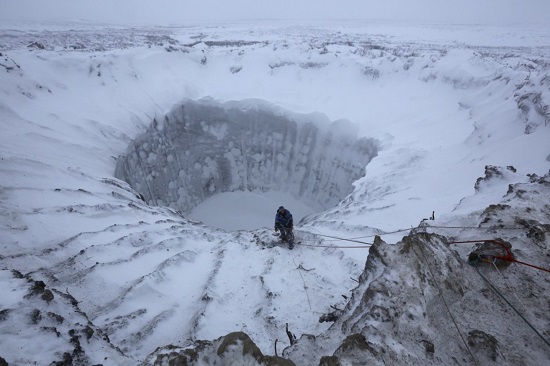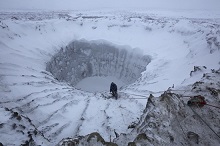Is the melting Arctic poised to release catastrophic quantities of methane? Actually, that’s one thing we don’t have to worry about, says Anil Ananthaswamy in a New Scientist article (paywalled). I’ve read the article, and I haven’t quite stopped worrying. Not quite.
Much of the concern has been generated by Natalia Shakhova of the University of Alaska at Fairbanks. Over the last 20 years her team has made over 30 expeditions studying methane release in more than 100 hot spots in the Arctic Ocean. In 2010 her team published a paper that calculated the effect of releasing 3% of the total store of methane in a 5-year period. They found that the extra methane would lead to additional warming of 1.3°C. She didn’t say it would happen, she said it could happen. She has her detractors.
Firstly, Patrick Crill from Stockholm University also studies Arctic methane release. Shakhova claims to have measured hotspots releasing 8000 parts per billion. Crill traipsed all over the Arctic on a Swedish icebreaker and found nothing above 2000 ppb from any of her hotspots.
Then there is the issue of how much of the stuff is down there. Quite a lot, says Shakhova, and quite shallow as the water rose 120 metres from the last ice age. She says that there is 1750 gigatonnes of carbon locked up, that’s roughly twice current atmospheric carbon. Carolyn Ruppel of the US Geological Survey in Woods Hole heads their gas hydrates project. She reckons only 20 gigatonnes!
Obviously they can’t both be right! The range is astonishing.
Others say that it would take thousands of years for warm water to reach where the carbon is. And to have any effect on the climate, because methane degrades rapidly in the atmosphere, it would need to come out quickly. As BilB said here the issue is about the rate of release rather than the total amount. Methane degrades into CO2 and water over time. In the first year it is 100 times more potent than CO2. After 20 years it is 75 times more potent.
The degradation curve for the first 100 years is shown in this graph from Dessus et al:

Another line of argument looks at the paleo record. There is no spike in methane in the ice core record from the Eemian, 125,000 years ago, nor from the Arctic warm period about 6000 years ago.
So a spike from the Arctic Ocean looks unlikely up to 2°C of warming, which, however, could be achieved by 2036, if I recall correctly from Michael Mann. Beyond that we are in new territory.
I’m impressed by how much we appear not to know. While we know so little I don’t think we can rest easily.
If Ruppel is right about the quantities, there is no problem. If Shakhova is right, the issue is about the timing and rate of release and any feedbacks this may cause.
David Archer thinks the whole methane bomb issue is a distraction from the main problem of CO2 and that the effect is likely to be more chronic than catastrophic. Nevertheless risk and uncertainty remain and the stakes are high. We do have to attend to methane in any case since CO2 only accounts for about 75% of the greenhouse effect. Methane is the second most significant greenhouse gas.
The critics of methane alarmism also think the land-based permafrost melting is likely to be more chronic than catastrophic. Land-based permafrost is said to contain another 1700 billion tonnes of carbon.
As permafrost melts giant craters form, like bomb craters, in the frozen layer of carbon matter, which is up to 30 metres deep:

Ananthaswamy reports that a team working for Gavin Schmidt, now head of NASA GISS, found that methane output from melting permafrost could lift atmospheric methane by about 800 parts per billion, as against current levels of 1900 ppb.
David Archer has calculated that 20 million craters would have to form to generate enough methane to achieve 50 gigatonnes within five years as envisaged in Shakhova’s scenario.
What puzzles me is that as far back as 2011 Dr. Kevin Schaefer found that microbes turn the plant matter into food and consequently CO2 is released into the atmosphere, not methane. Schaefer found that by the mid-2030s permafrost could be adding more than one billion tons of carbon a year. That’s about 10% of the carbon presently being emitted by fossil fuels.
The real problem, however, is that the permafrost turns from a carbon sink to a carbon source “strong enough to cancel 42-88% of the total global land sink.”
Recently Dr Roy Spencer and others found that the conversion to CO2 happens very rapidly:
- “We found that decomposition converted 60% of the carbon in the thawed permafrost to carbon dioxide in two weeks,” says Aron Stubbins, assistant professor at the University of Georgia’s Skidaway Institute of Oceanography. “This shows that permafrost carbon is definitely in a form that can be used by the microbes.
Dr Spencer:
- “When you have a huge frozen store of carbon and it’s thawing, we have some big questions. The primary question is, when it thaws, what happens to it?
“Our research shows that this ancient carbon is rapidly utilised by microbes and transferred to the atmosphere, leading to further warming in the region, and therefore more thawing. So we get into a runaway effect.”
Ananthaswamy doesn’t mention Spencer’s work and there is no indication that Schmidt’s team took it into account.
For me it’s still a case of known unknowns and hence a cause of worry. I’ll finish with Roger Jones’ comment on Item 3 of Climate clippings 85 dealing with a paper on vulnerability, risk and adaptation:
- Thoroughly recommend the adaptation framing paper by Ben, Johanna and Megan.
The vulnerability/risk thing that Ben describes is totally peppered through Working Group I and the SREX report – my second biggest criticism of the climate science community’s framing of risk. (The biggest is gradualism)
The critics of Arctic methane and permafrost alarmism seem to me to be gradualists. It seems to me that by mid-century surprises may be in store.


This is a link to a webpage maintained in memory by Paul Axford, son (I believe) of Sir Ian Axford who in his later years strove to high light the methane release risks of Arctic Permafrost Thawing. The website also links to the Sir Ian Axford memorial webcam which looks out across Napier NZ.
Brian: I seem to recall that methane ice stored in the ocean deeps was also a problem?
Oops there is the link
http://paulaxford.com/html/climate_change/index.htm
John, this post (see the second image) shows ocean methane deposits all around the world. I don’t think outgassing is a problem, though mining could be.